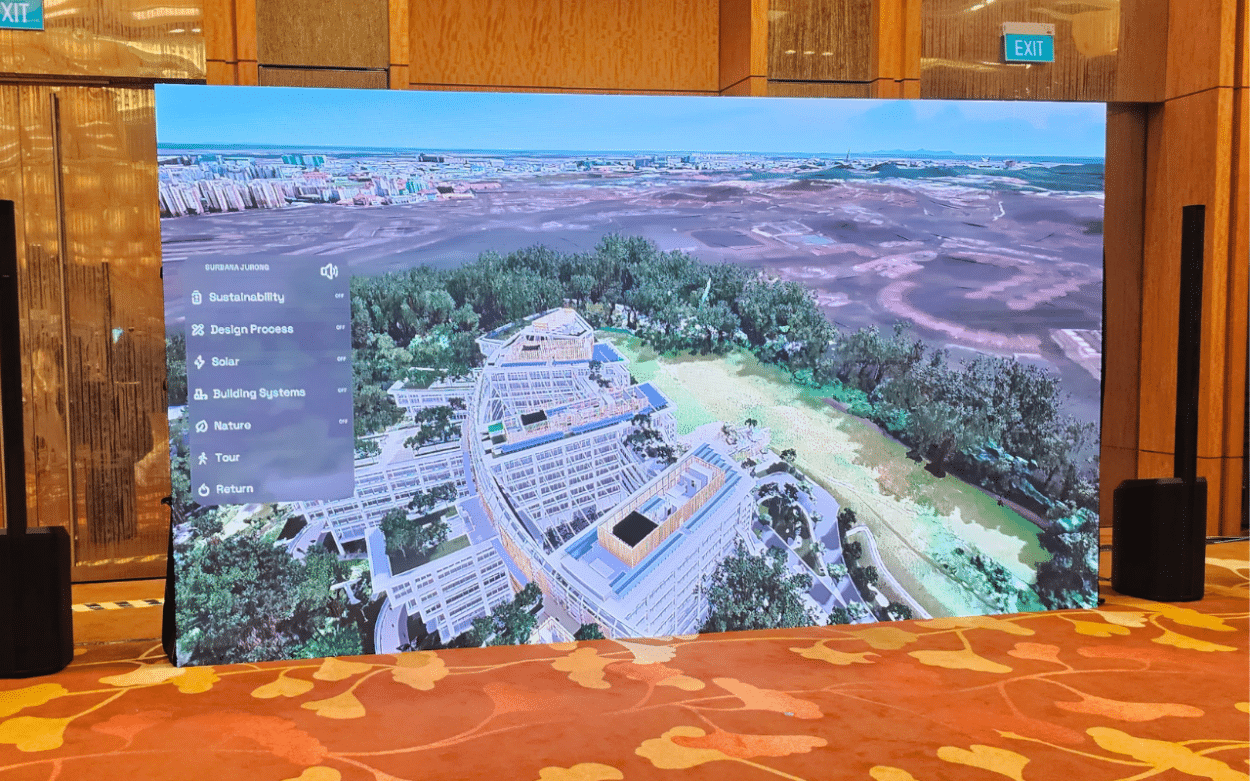During Bentley System’s Year in Infrastructure Conference that was held in Singapore a couple of weeks ago, we spoke with Marc Biagi, Senior Director of Energy Industry Solutions at Bentley Systems. Our conversation revolved around the infrastructure industry’s vital role in adapting to climate change and supporting the transition to cleaner energy sources and the need for greater intelligence in infrastructure management. We also explored the significant contributions AI can make to this sector.

Bentley is actively engaged in the global energy transition. What are the primary challenges facing the industry as it transitions towards sustainable energy practices?
Marc Biagi: “Over the past 100 years, our energy system has heavily relied on hydrocarbon resources, including coal, gas, and oil. They have powered the world’s growth and development in countless ways, from lighting our homes to driving industrial processes and supporting the entire built environment. They have played an instrumental role in modernizing various sectors, including steel manufacturing which produces a lot of the infrastructure that we need. But this intricate interdependence also introduces a challenging aspect and transitioning away from this model is very difficult.
The first challenge arises from the entrenched nature of these energy sources and power generation systems, designed around a centralized model of energy distribution. To successfully navigate the energy transition, the industry must transition to a more interconnected system that integrates renewable energy sources. However, the production of renewable energy components, such as offshore wind farms, steel structures, copper, lithium, and battery storage, also remains carbon-intensive, which contributes to the challenges.
There is also a latency in shifting towards a more intricate and interconnected energy landscape. High energy costs, material costs, shipping, and labor expenses are hindering the transition to low-carbon alternatives. And it is also more complex. For example, offshore wind projects, while remarkable, require backup solutions for times when the wind doesn’t blow, making energy storage and Peaker plants essential. Establishing a well-coordinated system that connects the supply side with the demand side and incorporates advanced demand and control measures is crucial for success.
There’s also the need to redefine our approach to energy, considering options beyond burning for heat generation. Direct heat sources like geothermal energy, combined with solar power and efficient wind power, offer promising solutions.
The good news is that there is a considerable amount of energy available within the system. When you consider the energy derived from the sun, the wind, and the sea, you’ll realize that we have only begun to tap into these vast resources. Therefore, with the right approach, although it will take time and require meticulous optimization and design, we can harness this energy potential more effectively. We must address various challenges related to planning, obtaining consent, engaging stakeholders, and fostering collaboration among the different companies involved in creating these systems. Leveraging digital twins and data-centric applications, we can create comprehensive digital models, not only for individual components but for the entire system. This will enable us to optimize our efforts more efficiently.”


In this year’s Year in Infrastructure event, Bentley is placing significant emphasis on infrastructure intelligence. What’s the underlying concept behind this?
Marc Biagi: “Infrastructure Intelligence is the combination of IT (Information Technology), OT (Operational Technology), and ET (Engineering Technology). IT pertains to the existing information technology systems in place, such as asset management systems, GIS systems, and maintenance management systems – tools used regularly. OT involves operational technologies, encompassing inspection data and monitoring systems, which might have varying frequencies. This could include reality modeling and time-series data that provide insights into how assets evolve over time. These time frequencies can range from very short, high-frequency data to lower-frequency data. ET focuses on comprehending the physical infrastructure within its environmental context. It involves understanding the systems that bring together the components of infrastructure.
The integration of IT, OT, and ET is the essence of infrastructure intelligence, placing infrastructure in a context that wasn’t possible before. It dismantles the silos that often segregate systems and can also involve engineering simulation data. For example, data residing in finite element analysis programs can provide insights into how certain load conditions might cause deflections. By combining engineering simulation data with real-time monitoring systems, it becomes possible to receive immediate feedback on asset performance, detect deflections, and assess whether performance falls within expected parameters or deviates. This kind of insight contributes to more informed decisions regarding infrastructure, maintenance, upgrade programs, and optimization of performance.”

As we discuss this, we’re considering future infrastructure, but what about the existing infrastructure? How can it adapt to climate change?
Marc Biagi: “Another critical aspect is adaptation and resilience in the face of climate change. This involves preparing for more frequent, high-intensity storms and the structural engineering required to withstand them. We need to enhance our understanding of existing infrastructure to perform vulnerability assessments, including factors like vegetation management and the impact of high-intensity winds from varying directions, which might differ from the initial assumptions.
In some countries, such as the United States, specific regulations and codes govern the types of analyses and wind intensities required from different directions. This is precisely what our software addresses. We offer two packages: Power Line Systems, which focuses on overhead line transmission systems, and SPIDA, which operates at the distribution system level, including the poles and cable-carrying infrastructure. These packages model the infrastructure and network, applying vector loading to simulate extreme wind conditions and assess their effects.
Our software correlates this data with inspection data, including information on the condition of poles, their age, connectors, and more. The goal is to mitigate risks, allowing utilities to optimize their capital and operational upgrade projects, as well as maintenance efforts, thus making more informed resource allocation decisions. This approach aims to maximize the effectiveness of investments while minimizing the potential for catastrophic events like the Hawaii wildfires. It’s crucial to remain vigilant and proactive in the face of such challenges, as unpredictable and severe weather patterns could lead to increasingly frequent disasters. Our commitment lies in adapting and building resilience to the evolving climate landscape.”


In terms of digital twin maturity, which industrial sectors have emerged as pioneers in harnessing these technologies effectively?
Marc Biagi: “The upstream oil and gas industry stands out as a prime example due to its sheer scale, complexity, and operation in challenging environments. The necessity to optimize operations has driven them to implement digital twin systems with exceptional precision.
Nuclear power generation is another sector that has played a pivotal role in advancing digital twins. Learnings from early incidents, such as the Three Mile Island, prompted the development of comprehensive configuration management processes. These processes seamlessly link the physical infrastructure with the digital counterpart and align them with stringent regulatory standards, ensuring constant compliance.
This paradigm shift in nuclear power management has also made its mark on the rail industry. Rail transport continues to grapple with challenges. We’ve seen unfortunate derailments caused by issues like landslips because it wasn’t reported effectively on the network. The imperative here is to effectively report and address these problems, presenting ongoing challenges, but also opportunities for optimization.
Regulated industries like water utilities have joined the digital twin bandwagon, primarily due to their aging and often subterranean infrastructure. Understanding this network’s intricacies is crucial, albeit at a different level of complexity compared to the oil and gas sector.”

Bentley has announced its ongoing efforts to implement AI within its operations. Could you please provide more information regarding how you plan to utilize AI?
Marc Biagi: “A straightforward example of this is related to our vulnerability assessment. In cases where power utilities manage a vast number of assets spread across a wide area, we are utilizing AI to collect data from drone photogrammetry at a high resolution. Instead of relying solely on human interpretation of the results, AI is now employed to identify defects and correlate various data sources, including visual and thermographic data.
Thermography, involving infrared technology to detect hotspots, plays a crucial role in this process. By consolidating all available data sources and providing them to AI, we can significantly enhance the precision of our mitigation efforts.
We have already demonstrated numerous instances where AI is proficient at identifying issues such as corrosion and physical defects. These findings are then classified and integrated into the digital twin, where they can offer support. Additionally, our AI capabilities extend to industries that deal with paper-based and 2D graphical data, as opposed to data-centric, data-driven schematics. In such cases, our AI capabilities can extract and structure data, setting the foundation for data-centric operations.”











